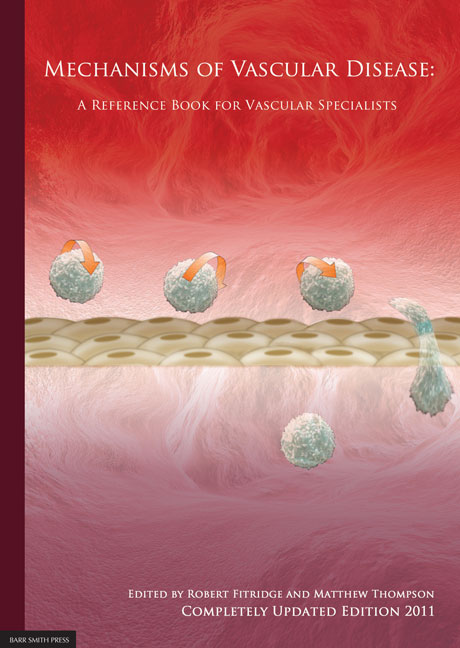Book contents
- Frontmatter
- Contents
- List of Contributors
- Detailed Contents
- Acknowledgements
- Abbreviation List
- 1 Endothelium
- 2 Vascular smooth muscle structure and function
- 3 Atherosclerosis
- 4 Mechanisms of plaque rupture
- 5 Current and emerging therapies in atheroprotection
- 6 Molecular approaches to revascularisation in peripheral vascular disease
- 7 Biology of restenosis and targets for intervention
- 8 Vascular arterial haemodynamics
- 9 Physiological Haemostasis
- 10 Hypercoagulable States
- 11 Platelets in the pathogenesis of vascular disease and their role as a therapeutic target
- 12 Pathogenesis of aortic aneurysms
- 13 Pharmacological treatment of aneurysms
- 14 Pathophysiology of Aortic dissection and connective tissue disorders
- 15 Biomarkers in vascular disease
- 16 Pathophysiology and principles of management of vasculitis and Raynaud's phenomenon
- 17 SIRS, sepsis and multiorgan failure
- 18 Pathophysiology of reperfusion injury
- 19 Compartment syndromes
- 20 Pathophysiology of pain
- 21 Post-amputation pain
- 22 Treatment of neuropathic pain
- 23 Principles of wound healing
- 24 Pathophysiology and principles of varicose veins
- 25 Chronic venous insufficiency and leg ulceration: Principles and vascular biology
- 26 Pathophysiology and principles of management of the diabetic foot
- 27 Lymphoedema – Principles, genetics and pathophysiology
- 28 Graft materials past and future
- 29 Pathophysiology of vascular graft infections
- Index
17 - SIRS, sepsis and multiorgan failure
Published online by Cambridge University Press: 05 June 2012
- Frontmatter
- Contents
- List of Contributors
- Detailed Contents
- Acknowledgements
- Abbreviation List
- 1 Endothelium
- 2 Vascular smooth muscle structure and function
- 3 Atherosclerosis
- 4 Mechanisms of plaque rupture
- 5 Current and emerging therapies in atheroprotection
- 6 Molecular approaches to revascularisation in peripheral vascular disease
- 7 Biology of restenosis and targets for intervention
- 8 Vascular arterial haemodynamics
- 9 Physiological Haemostasis
- 10 Hypercoagulable States
- 11 Platelets in the pathogenesis of vascular disease and their role as a therapeutic target
- 12 Pathogenesis of aortic aneurysms
- 13 Pharmacological treatment of aneurysms
- 14 Pathophysiology of Aortic dissection and connective tissue disorders
- 15 Biomarkers in vascular disease
- 16 Pathophysiology and principles of management of vasculitis and Raynaud's phenomenon
- 17 SIRS, sepsis and multiorgan failure
- 18 Pathophysiology of reperfusion injury
- 19 Compartment syndromes
- 20 Pathophysiology of pain
- 21 Post-amputation pain
- 22 Treatment of neuropathic pain
- 23 Principles of wound healing
- 24 Pathophysiology and principles of varicose veins
- 25 Chronic venous insufficiency and leg ulceration: Principles and vascular biology
- 26 Pathophysiology and principles of management of the diabetic foot
- 27 Lymphoedema – Principles, genetics and pathophysiology
- 28 Graft materials past and future
- 29 Pathophysiology of vascular graft infections
- Index
Summary
EPIDEMIOLOGY
Sepsis remains a common reason for intensive care unit (ICU) admission and is a leading cause of mortality. This disease is now recognized to be a time-sensitive emergency, because patients stand the best chance for survival when effective therapeutic interventions are delivered as early as possible. However, consistent data are lacking regarding the incidence and outcome of sepsis in ICUs globally. Data extrapolated from a cohort study conducted by Finfer et al in 2004 across twenty three closed multidisciplinary ICUs showed that the incidence of severe sepsis among adult patients was 0.77 patients per 1000 population (95% CI, 0.76–0.79). There were 752 episodes of severe sepsis identified in 691 patients, equating to 11.8 patients with severe sepsis per 100 ICU admissions (95% CI, 10.9–12.6). The EPISEPSIS study group conducted a nationwide, prospective, multicentre survey of patients with severe sepsis in 206 French ICUs over two consecutive weeks. They estimated the incidence of severe sepsis to be 0.95 cases per 1000 in the French population. In the United States between 1979 and 2000 an annualized increase of 8.7% in the incidence of sepsis was noted. (From about 164,000 cases (0.82 per 1000 population) to nearly 660,000 cases (2.4 per 1000 population)).
Sepsis is estimated to affect 18 million people worldwide each year and kill 1400 people each day. According to an epidemiological study, sepsis affects about 700,000 people annually in the United States alone, with an overall mortality rate of 30%, or more than 50% in patients with septic shock and/or multiple system organ failure.
- Type
- Chapter
- Information
- Mechanisms of Vascular DiseaseA Reference Book for Vascular Specialists, pp. 315 - 330Publisher: The University of Adelaide PressPrint publication year: 2011
- 5
- Cited by



